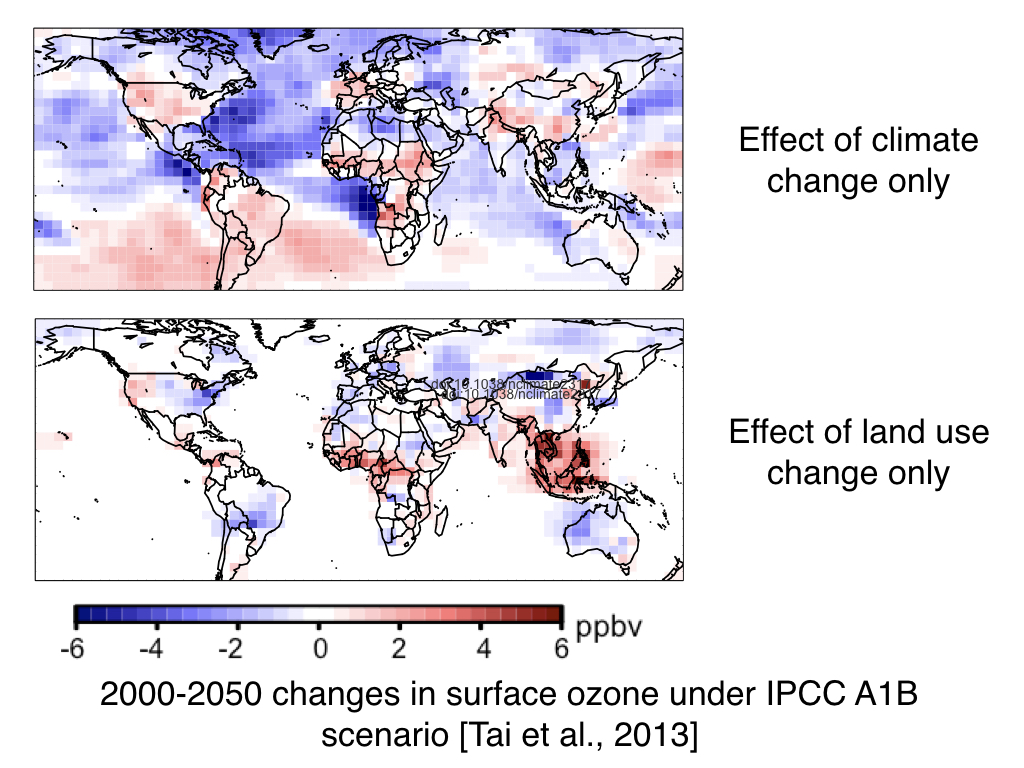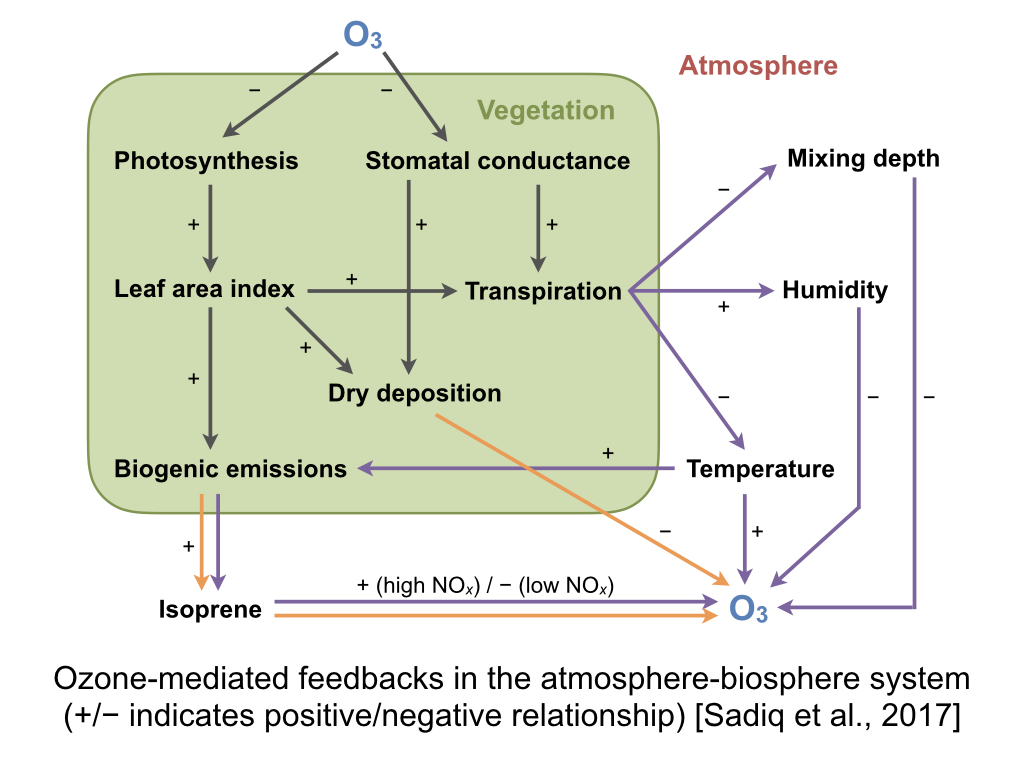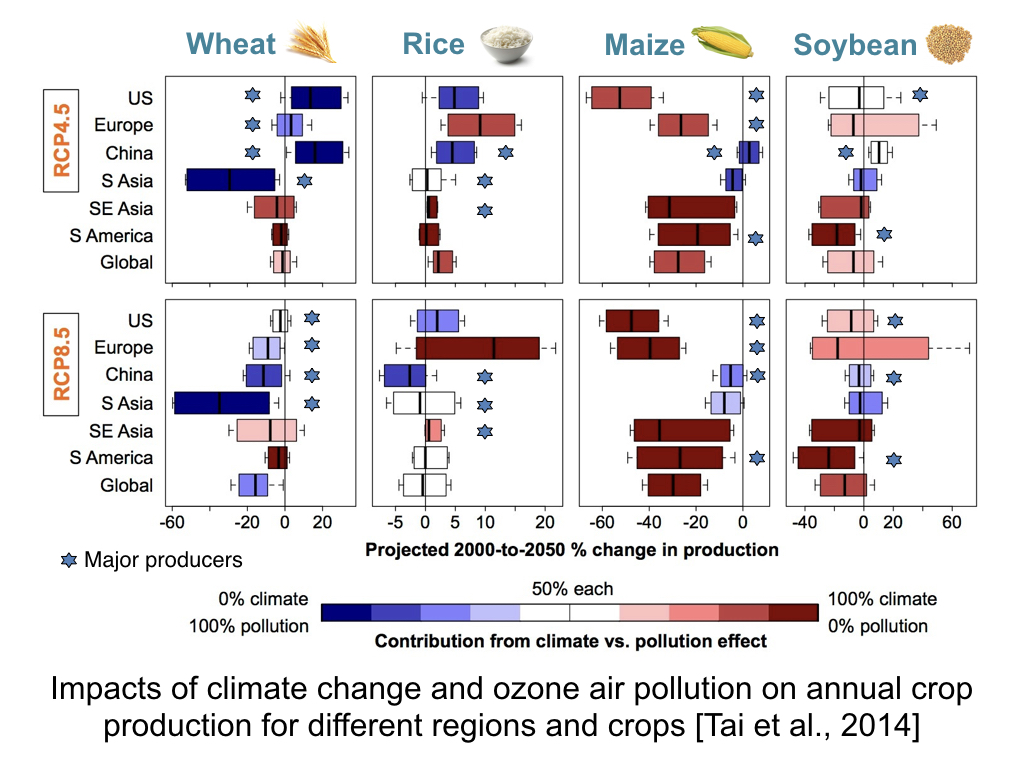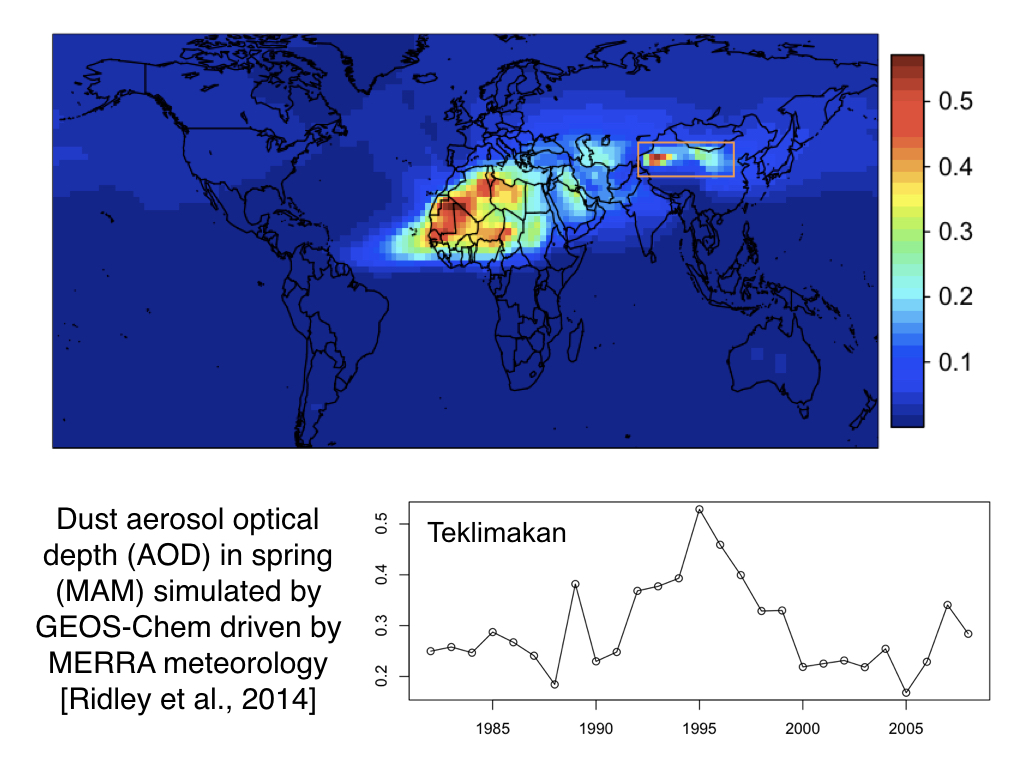
|
Impacts of land cover, land use, agricultural and forest changes on air quality and climate Air pollution and climate change are not only dependent on emissions but also strongly sensitive to changes in climate and the underlying land surface. Here we investigate the impacts of historical and future climate and land cover changes, including in anthropogenic land use, on global and East Asian air quality, with a focus on surface ozone and fine particulate matter (PM2.5). We combine coupled climate-biosphere-chemistry modeling (e.g., GEOS-Chem, CESM) and multivariate statistical analysis of global observations to examine the importance of various factors including synoptic weather systems, local meteorology, plant distribution and structure, as well as deforestation, agricultural expansion and intensification. References: |
|
Air pollutant-climate-vegetation interactions and their implications for air quality, climate change and ecosystem productivity Vegetation is strongly sensitive not only to meteorological conditions and climatic stress, but also to atmospheric composition (e.g., CO2 and ozone levels). Changes in plant activities (e.g., photosynthesis, stomatal conductance, leaf growth, terpenoid production) in response to climatic and atmospheric chemical changes can in turn modify many land-atmosphere processes (e.g., evapotranspiration, dry deposition, biogenic emissions), with ramifications for air quality and climate. Here we develop and integrate biosphere-atmosphere coupling in different models (e.g., CESM, GEOS-Chem, TEMIR) to examine how climatic stress, ozone damage on plants, and rising CO2 can influence atmospheric chemistry, boundary-layer meteorology and ecosystem productivity via various vegetation-mediated pathways. We also seek sustainable forestry practices with co-benefits for human and ecosystem health. References: |

|

|
Sustainable agriculture and food security under global environmental changes Climate change and air pollution pose substantial threats to global food security. Meanwhile, modern modes of agriculture are unsustainable and have caused serious environmental problems. Here we combine mechanistic and statistical modeling of the interactions between crops, air pollutants and climatic stress to investigate the effects of climate change and air pollution on global crop production. We also examine how sustainable food production methods (e.g., intercropping, drip irrigation) and food consumption patterns (e.g., plant-based diet) may reduce greenhouse gas and air pollutant emissions (with a focus on reactive nitrogen), and thus alleviate the environmental impacts of agriculture. References: |
|
Factors controlling East Asian dust variability and implications for ocean biogeochemistry and climate Climate and land surface changes can significantly influence the interannual variability of dust emission from major deserts. As dust iron is an important nutrient for marine phytoplankton, dust transported downwind can in turn affect ocean biogeochemistry and carbon uptake. Here we investigate the climatic and surficial factors controlling the interannual variability of East Asian dust emission and transport using a combination of satellite observations and atmospheric modeling (with GEOS-Chem). We further implement a simplified scheme for dust iron chemistry to probe into the possible linkage to observed ecosystem changes in the North Pacific. References: |

|
Research > Publications
Full list of publications:
(* indicates corresponding authorship.)
• Liu, X., Zhai, S., Li, K., Zhu, L., Liu, S., Shah, V., Tai, A. P. K., Geng, G., Hou, X., Mamtimin, A., Li, X., & Zhao, T.* (2025). Particulate matter (PM) and ozone air quality in Urumqi of Northwest China: Seasonality, trends, and sources. Atmospheric Environment, 350, 121150. [link]
• Ismaeel, A., Wu., J., & Tai, A. P. K.* (2025). Fine-scale assessment of blue-water dependence via crop rotation systems in South Asia under a changing climate. Environmental Research Letters, 20(5), 054031. [link]
• Yuan, T., Fu, T.-M., Zhang, A., Yung, D. H. Y., Wu, J., Li, S., & Tai, A. P. K.* (2025). Impacts of irrigation on ozone and fine particulate matter (PM2.5) air quality: implications for emission control strategies for intensively irrigated regions in China. Atmospheric Chemistry and Physics, 25(7), 4211-4232. [link]
• Yuen, N. L., Leung, F.*, Chau, K. T., Hung, S. K., Lee, S. Y., & Tai, A. P. K. (2025). Examining environmental factors behind the declining occurrence of dolphins in Hong Kong waters using multivariate statistical methods. Marine Pollution Bulletin, 213, 117655. [link]
• Luo, B., Huang, J., Liu, X., Kwan, M.-P.*, & Tai, A. P. K.* (2025). Dietary changes are associated with an increase in air pollution-related health and environmental inequity in China. Communications Earth & Environment, 6, 79. [link]
• Tai, A. P. K.*, Luo, L., & Luo, B. (2025). Opinion: Understanding the impacts of agriculture and food systems on atmospheric chemistry is instrumental to achieving multiple Sustainable Development Goals. Atmospheric Chemistry and Physics, 25(2), 923-941. [link]
• Ismaeel, A., Tai, A. P. K.*, & Wu, J. (2024). Understanding the spatial patterns of atmospheric ammonia trends in South Asia. Science of The Total Environment, 954, 176188. [link]
• Agathokleous, E., Emberson, L., Pei, J., Kobayashi, K., Blande, J. D., Cook, J., Fang, C., Han, Z., Ju, H., Knopf, O., Li, T., Liu, B., Liu, X., Masui, N., Masutomi, Y., McHugh, K., O’Neill, C., Pande, P., Rasheed, M. U., Ruhanen, H., Shang, B., Tai, A. P. K., Yamaguchi, M., Yu, Z., Yuan, X., Xu, Y., Zhao, C., Zhao, J., Zheng, H., Zhou H., & Feng, Z.* (2024). Insights from the international workshop on “Adapting agriculture to climate change and air pollution”. Environmental Science and Pollution Research, 31, 65905-65913. [link]
• Zhang, H., Lee, C. K. F., Law, Y. K., Chan, A. H. Y., Zhang, J., Gale, S. W., Hughes, A., Ledger, M. J., Wong, M. S., Tai, A. P. K., Hau, B. C. H., & Wu, J.* (2024). Integrating both restoration and regeneration potentials into real-world forest restoration planning: A case study of Hong Kong. Journal of Environmental Management, 369, 122306. [link]
• Bhattarai, H., Tai, A. P. K.*, Val Martin, M.*, & Yung, D. H. Y. (2024). Responses of fine particulate matter (PM2.5) air quality to future climate, land use, and emission changes: Insights from modeling across shared socioeconomic pathways. Science of The Total Environment, 948, 174611. [link]
• Murray, L. T.*, Leibensperger, E. M., Mickley, L. J., & Tai, A. P. K. (2024). Estimating future climate change impacts on human mortality and crop yields via air pollution. Proceedings of the National Academy of Sciences of the United States of America, 121(39), e2400117121. [link]
• Tai, A. P. K.*, Yung, D. H. Y., & Lam, T. (2024). Terrestrial Ecosystem Model in R (TEMIR) version 1.0: simulating ecophysiological responses of vegetation to atmospheric chemical and meteorological changes. Geoscientific Model Development, 17(9), 3733–3764. [link]
• Tai, A. P. K.* (2024). Co-benefits of sustainable food production and consumption in mitigating air pollution and climate change via the nitrogen cycle. In H.-M. Lam (Ed.), Agrobiotechnology in Perspectives: History, Economy, Science and Technology on the Plate (pp. 165-180). World Scientific. [link]
• Ismaeel, A., Tai, A. P. K., Santos, E. G., Maraia, H., Aalto, I., Altman, J., Dolezal, J., Lembrechts, J. J., Camargo, J. L., Aalto, J., Sam, K., do Nascimento, L. C. A., Kopecky, M., Svátek, M., Nunes, M. H., Matula, R., Plichta, R., Abera, T., & Maeda, E. E.* (2024). Patterns of tropical forest understory temperatures. Nature Communications, 15(1), 549. [link]
• Mao, J., Tai, A. P. K.*, Yung, D. H. Y., Yuan, T., Chau, K. T., & Feng, Z (2024). Multidecadal ozone trends in China and implications for human health and crop yields: A hybrid approach combining a chemical transport model and machine learning. Atmospheric Chemistry and Physics, 24(1), 345-366. [link]
• Bhattarai, H., Tai, A. P. K.*, Val Martin, M.*, & Yung, D. H. Y. (2024). Impacts of changes in climate, land use, and emissions on global ozone air quality by mid-21st century following selected Shared Socioeconomic Pathways. Science of The Total Environment, 906, 167759. [link]
• Yuan, T., Tai, A. P. K.*, Mao, J., Tam, O. H. F., Li, R. K. K., Wu, J., & Li, S. (2023). Effects of different irrigation methods on regional climate in North China Plain: A modeling study. Agricultural and Forest Meteorology, 342, 109728. [link]
• Val Martin, M.*, Blanc-Betes, E., Fung, K. M., Kantzas, E. P., Kantola, I. B., Chiaravalloti, I., Taylor, L. L., Emmons, L. K., Wieder, W. R., Planavsky, N. J., Masters, M. D., DeLucia, E. H., Tai, A. P. K., & Beerling, D. J. (2023). Improving nitrogen cycling in a land surface model (CLM5) to quantify soil N2O, NO, and NH3 emissions from enhanced rock weathering with croplands. Geoscientific Model Development, 16(20), 5783-5801. [link]
• Moch, J. M.*, Mickley, L. J., Eastham, S. D., Lundgren, E. W., Shah, V., Buonocore, J. J., Pang, J. Y. S., Sadiq, M., & Tai, A. P. K. (2023). Overlooked long-term atmospheric chemical feedbacks alter the impact of solar geoengineering: Implications for tropospheric oxidative capacity. AGU Advances, 4(5), e2023AV000911. [link]
• Clifton, O. E.*, Schwede, D., Hogrefe, C., Bash, J. O., Bland, S., Cheung, P., Coyle, M., Emberson, L., Flemming, J., Fredj, E., Galmarini, S., Ganzeveld, L., Gazetas, O., Goded, I., Holmes, C. D., Horváth, L., Huijnen, V., Li, Q., Makar, P. A., Mammarella, I., Manca, G., Munger, J. W., Pérez-Camanyo, J. L., Pleim, J., Ran, L., San Jose, R., Silva, S. J., Staebler, R., Sun, S., Tai, A. P. K., Tas, E., Vesala, T., Weidinger, T., Wu, Z., & Zhang, L. (2023). A single-point modeling approach for the intercomparison and evaluation of ozone dry deposition across chemical transport models (Activity 2 of AQMEII4). Atmospheric Chemistry and Physics, 23(17), 9911-9961. [link]
• Lam, J. C. Y., Tai, A. P. K.*, Ducker, J. A., & Holmes, C. D. (2023). Development of an ecophysiology module in the GEOS-Chem chemical transport model version 12.2.0 to represent biosphere–atmosphere fluxes relevant for ozone air quality. Geoscientific Model Development, 16(9), 2323-2342. [link]
• Fung, K. M.*, Saikawa, E.*, & Tai, A. P. K.* (2023). Editorial: Agriculture and food supply challenges in a changing climate. Frontier in Climate, 4, 1113825. [link]
• Wang, Y. X.*, Lin, N., Li, W., Guenther, A., Lam, J. C. Y., Tai, A. P. K., Potosnak, M. J., & Seco, R. (2022). Satellite-derived constraints on the effect of drought stress on biogenic isoprene emissions in the southeastern US. Atmospheric Chemistry and Physics, 22(21), 14189-14208. [link]
• Wu, R., Agathokleous, E., Yung, D. H. Y., Tai, A. P. K., Shang, B., & Feng, Z.* (2022). Joint impacts of ozone pollution and climate change on yields of Chinese winter wheat. Atmospheric Pollution Research, 13(8), 101509. [link]
• Leung, F.*, Sitch, S., Tai, A. P. K., Wiltshire, A. J., Gornall, J. L., Folberth, G. A., & Unger, N. (2022). CO2 fertilization of crops offsets yield losses due to future surface ozone damage and climate change. Environmental Research Letters, 17(7), 074007. [link]
• Sun, S., Tai, A. P. K.*, Yung, D. H. Y., Wong, A. Y. H., Ducker, J. A., & Holmes, C. D. (2022). Influence of plant ecophysiology on ozone dry deposition: Comparing between multiplicative and photosynthesis-based dry deposition schemes and their responses to rising CO2 level. Biogeosciences, 19(6), 1753-1776. [link]
• Fung, K. M.*, Val Martin, M.*, & Tai, A. P. K.* (2022). Modeling the interinfluence of fertilizer-induced NH3 emission, nitrogen deposition, and aerosol radiative effects using modified CESM2. Biogeosciences, 19(6), 1635-1655. [link]
• Zhu, J., Tai, A. P. K.*, & Yim, S. H. L.* (2022). Effects of ozone-vegetation interactions on meteorology and air quality in China using a two-way coupled land-atmosphere model. Atmospheric Chemistry and Physics, 22(2), 765-782. [link]
• Liu, X., Tai, A. P. K.*, Chen, Y., Zhang, L., Shaddick, G., Yan, X., & Lam, H.-M. (2021). Dietary shifts can reduce premature deaths related to particulate matter pollution in China. Nature Food, 2(12), 997-1004. [link] [full article]
• Liu, X., Tai, A. P. K.*, & Fung, K. M. (2021). Responses of surface ozone to future agricultural ammonia emissions and subsequent nitrogen deposition through terrestrial ecosystem changes, Atmospheric Chemistry and Physics, 21(23), 17743-17758. [link]
• Tai, A. P. K.*, Ma, P. H. L., Chan, Y.-C., Chow, M.-K., Ridley, D. A., & Kok, J. F. (2021). Impacts of climate and land cover variability and trends on springtime East Asian dust emission over 1982–2010: A modeling study. Atmospheric Environment, 254, 118348. [link]
• Tai, A. P. K.*, Sadiq, M., Pang, J. Y. S., Yung, D. H. Y., & Feng, Z. (2021). Impacts of surface ozone pollution on global crop yields: Comparing different ozone exposure metrics and incorporating co-effects of CO2. Frontiers in Sustainable Food Systems, 5, 534616. [link]
• Lee, C. H. Y., Tang, A. M. C.*, Lai, D. Y. F.*, Tai, A. P. K.*, Leung, A. S. L.*, Tao, D. K. C., Leung, F., Leung, S. S. M., Wu, C., Tong, S. C. S., & Ng, K. T. K. (2021). Problems and management of Acacia-dominated urban forests on man-made slopes in a subtropical, high-density city. Forests, 12(3), 323. [link]
• Chong, M.-L.*, Wong, Y.-C.*, Woo, W.-C., Tai, A. P. K., & Wong, W.-K. (2021). Calibration of high-impact short-range quantitative precipitation forecast through frequency-matching techniques. Atmosphere, 12(2), 247. [link]
• Li, J., Tam, C.-Y.*, Tai, A. P. K.*, & Lau, N.-C. (2021). Vegetation-heatwave correlations and contrasting energy exchange responses of different vegetation types to summer heatwaves in the Northern Hemisphere during the 1982–2011 period. Agricultural and Forest Meteorology, 296, 108208. [link]
• Leung, F.*, Williams, K., Sitch, S., Tai, A. P. K., Wiltshire, A., Gornall, J., Ainsworth, E. A., Arkebauer, T., & Scoby, D. (2020). Calibrating soybean parameters in JULES 5.0 from the US-Ne2/3 FLUXNET sites and the SoyFACE-O3 experiment. Geoscientific Model Development, 13(12), 6201-6213. [link]
• Wang, L., Tai, A. P. K.*, Tam, C.-Y.*, Sadiq, M., Wang, P., & Cheung, K. K. W. (2020). Impacts of future land use and land cover change on mid-21st-century surface ozone air quality: Distinguishing between the biogeophysical and biogeochemical effects. Atmospheric Chemistry and Physics, 20(19), 11349-11369. [link]
• Feng, Z.*, Hu, T., Tai, A. P. K., & Calatayud, V. (2020). Yield and economic losses in maize caused by ambient ozone in the North China Plain (2014–2017). Science of the Total Environment, 722, 137958. [link]
• Leung, F.*, Pang, J. Y. S., Tai, A. P. K., Lam, T., Tao, D. K. C., & Sharps, K. (2020). Evidence of ozone-induced visible foliar injury in Hong Kong using Phaseolus vulgaris as a bioindicator. Atmosphere, 11(3), 266. [link]
• Clifton, O. E.*, Fiore, A. M., Massman, W. J., Baublitz, C. B., Coyle, M., Emberson, L., Fares, S., Farmer, D. K., Gentine, P., Gerosa, G., Guenther, A. B., Helmig, D., Lombardozzi, D. L., Munger, J. W., Patton, E. G., Pusede, S. E., Schwede, D. B., Silva, S. J., Sörgel, M., Steiner, A. L., & Tai, A. P. K. (2020). Dry deposition of ozone over land: processes, measurement, and modeling. Reviews of Geophysics, 58(1), e2019RG000670. [link]
• Pope, R. J.*, Arnold, S. R., Chipperfield, M. P., Reddington, C. L. S., Butt, E. W., Keslake, T. D., Feng, W., Latter, B. G., Kerridge, B. J., Siddans, R., Rizzo, L., Artaxo, P., Sadiq, M., & Tai, A. P. K. (2020). Substantial increases in Eastern Amazon and Cerrado biomass burning‐sourced tropospheric ozone. Geophysical Research Letters, 47, e2019GL084143. [link]
• Wong, A. Y. H., Geddes, J. A.*, Tai, A. P. K., & Silva, S. J. (2019). Importance of dry deposition parameterization choice in global simulations of surface ozone. Atmospheric Chemistry and Physics, 19(22), 14365-14385. [link]
• Zhang, Y., Jiang, Y.*, Tai, A. P. K., Feng, J. F., Li, Z. J., Zhu, X. C., Chen, J., Zhang, J., Song, Z. W., Deng, A. X., Lal, Rattan, & Zhang, W. J.* (2019). Contribution of rice variety renewal and agronomic innovations to yield improvement and greenhouse gas mitigation in China. Environmental Research Letters, 14(11), 114020. [link]
• Fung, K. M., Tai, A. P. K.*, Yong, T., Liu, X., & Lam, H.-M. (2019). Co-benefits of intercropping as a sustainable farming method for safeguarding both food security and air quality. Environmental Research Letters, 14(4), 044011. [link]
• Foyer, C. H.*, Siddique, K. H. M., Tai, A. P. K., Anders, S., Fodor, N., Wong, F.-L., Ludidi, N., Chapman, M. A., Ferguson, B. J., Considine, M. J., Zabel, F., Prasad, P. V. V., Varshney, R. K., Nguyen, H. T., & Lam, H.-M. (2019). Modelling predicts that soybean is poised to dominate crop production across Africa. Plant, Cell and Environment, 42, 373–385. [link]
• Zhou, S. S., Tai, A. P. K.*, Sun, S., Sadiq, M., Heald, C. L., & Geddes, J. A. (2018). Coupling between surface ozone and leaf area index in a chemical transport model: strength of feedback and implications for ozone air quality and vegetation health. Atmospheric Chemistry and Physics, 18(19), 14133-14148. [link]
• Leung, D. M., Tai, A. P. K.*, Mickley, L. J., Moch, J. M., van Donkelaar, A., Shen, L., & Martin, R. V. (2018). Synoptic meteorological modes of variability for fine particulate matter (PM2.5) air quality in major metropolitan regions of China. Atmospheric Chemistry and Physics, 18(9), 6733-6748. [link]
• Wong, A. Y. H., Tai, A. P. K.*, & Ip, Y.-Y. (2018). Attribution and statistical parameterization of the sensitivity of surface ozone to changes in leaf area index based on a chemical transport model. Journal of Geophysical Research: Atmospheres, 123(3), 1883-1898. [link] [PDF]
• Wang, L., Cheung, K. K. W.*, Tam, C.-Y., Tai, A. P. K., & Li, Y. (2018). Evaluation of the Regional Climate Model over the Loess Plateau of China. International Journal of Climatology, 38(1), 35-54. [link]
• Zhang, H. L., Xing, J., Kota, H., Huang, L., & Tai, A. P. K. (2018). Editorial: Utilization of data from air quality monitoring networks. Environmental Research, 164, 9-10. [link]
• Tai, A. P. K.*, & Val Martin, M. (2017). Impacts of ozone air pollution and temperature extremes on crop yields: Spatial variability, adaptation and implications for future food security. Atmospheric Environment, 169, 11-21. [link]
• Zhao, Y., Zhang, L.*, Tai, A. P. K., Chen, Y., & Pan, Y. (2017). Responses of surface ozone air quality to anthropogenic nitrogen deposition in the Northern Hemisphere. Atmospheric Chemistry and Physics, 17(16), 9781-9796. [link]
• Sadiq, M., Tai, A. P. K.*, Lombardozzi, D., & Val Martin, M. (2017). Effects of ozone-vegetation coupling on surface ozone air quality via biogeochemical and meteorological feedbacks. Atmospheric Chemistry and Physics, 17, 3055-3066. [link]
• Fu, Y.*, Tai, A. P. K.*, & Liao, H. (2016). Impacts of historical climate and land cover changes on fine particulate matter (PM2.5) air quality in East Asia between 1980 and 2010. Atmospheric Chemistry and Physics, 16(16), 10369-10383. [link]
• Westervelt, D. M.*, Horowitz, L. W., Naik, V., Tai, A. P. K., Fiore, A. M., & Mauzerall, D. L. (2016). Quantifying PM2.5-meteorology sensitivities in a global climate model. Atmospheric Environment, 142, 43-56. [link]
• Shen, L.*, Mickley, L. J., & Tai, A. P. K. (2015). Influence of synoptic patterns on surface ozone variability over the eastern United States from 1980 to 2012. Atmospheric Chemistry and Physics, 15(19), 10925-10938. [link]
• Fu, Y., & Tai, A. P. K.* (2015). Impact of climate and land cover changes on tropospheric ozone air quality and public health in East Asia between 1980 and 2010. Atmospheric Chemistry and Physics, 15(17), 10093-10106. [link]
• Achakulwisut, P.*, Mickley, L. J., Murray, L. T., Tai, A. P. K., Kaplan, J. O., & Alexander, B. (2015). Uncertainties in isoprene photochemistry and emissions: implications for the oxidative capacity of past and present atmospheres and for climate forcing agents. Atmospheric Chemistry and Physics, 15(14), 7977-7998. [link]
• Tai, A. P. K.*, Val Martin, M., & Heald, C. L. (2014). Threat to future global food security from climate change and ozone air pollution. Nature Climate Change, 4(9), 817–821. [link] [PDF]
• Tai, A. P. K.*, Mickley, L. J., Heald, C. L., & Wu, S. (2013). Effect of CO2 inhibition on biogenic isoprene emission: Implications for air quality under 2000 to 2050 changes in climate, vegetation, and land use. Geophysical Research Letters, 40(13), 3479-3483. [link] [PDF]
• Tai, A. P. K.*, Mickley, L. J., & Jacob, D. J. (2012). Impact of 2000-2050 climate change on fine particulate matter (PM2.5) air quality inferred from a multi-model analysis of meteorological modes. Atmospheric Chemistry and Physics, 12(23), 11329-11337. [link]
• Tai, A. P. K.*, Mickley, L. J., Jacob, D. J., Leibensperger, E. M., Zhang, L., Fisher, J. A., & Pye, H. O. T. (2012). Meteorological modes of variability for fine particulate matter (PM2.5) air quality in the United States: implications for PM2.5 sensitivity to climate change. Atmospheric Chemistry and Physics, 12(6), 3131-3145. [link]
• Barrett, S. R. H.*, Yim, S. H. L., Gilmore, C. K., Murray, L. T., Kuhn, S. R., Tai, A. P. K., Yantosca, R. M., Byun, D. W., Ngan, F., Li, X., Levy, J. I., Ashok, A., Koo, J., Wong, H. M., Dessens, O., Balasubramanian, S., Fleming, G. G., Pearlson, M. N., Wollersheim, C., Malina, R., Arunachalam, S., Binkowski, F. S., Leibensperger, E. M., Jacob, D. J., Hileman, J. I., Waitz, I. A. (2012). Public health, climate, and economic impacts of desulfurizing jet fuel. Environmental Science and Technology, 46(8), 4275-4282. [link]
• Tai, A. P. K.*, Mickley, L. J., & Jacob, D. J. (2010). Correlations between fine particulate matter (PM2.5) and meteorological variables in the United States: Implications for the sensitivity of PM2.5 to climate change. Atmospheric Environment, 44(32), 3976-3984. [link] [PDF]
• Martiny, A. C.*, Tai, A. P. K., Veneziano, D., Primeau, F., & Chisholm, S. W. (2009). Taxonomic resolution, ecotypes and the biogeography of Prochlorococcus. Environmental Microbiology, 11(4), 823-832. [link]
